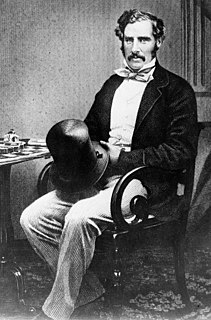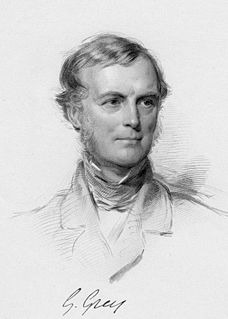
Earl Grey is a title in the Peerage of the United Kingdom. It was created in 1806 for General Charles Grey, 1st Baron Grey. In 1801, he was given the title Baron Grey of Howick in the County of Northumberland, and in 1806 he was created Viscount Howick in the County of Northumberland, at the same time as he was given the earldom. A member of the prominent Grey family of Northumberland, Earl Grey was the third son of Sir Henry Grey, 1st Baronet of Howick.
Baron de Mauley, of Canford in the County of Dorset, is a title in the Peerage of the United Kingdom. It was created in 1838 for the Whig politician the Hon. William Ponsonby, who had earlier represented Poole, Knaresborough and Dorset in the House of Commons. He was the third son of the 3rd Earl of Bessborough, an Anglo-Irish peer, and the husband of Lady Barbara Ashley-Cooper, one of the co-heirs to the ancient barony by writ of Mauley, which superseded the feudal barony the caput of which was at Mulgrave Castle, Yorkshire, which barony by writ had become extinct in 1415. His son, later the second Baron, sat as Member of Parliament for Poole and Dungarvon.

Marquess of Ripon, in the County of York was a title in the Peerage of the United Kingdom. It was created in 1871 for the Liberal politician George Robinson, 2nd Earl of Ripon.
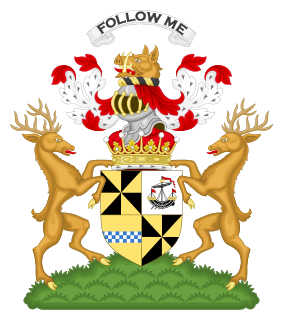
Earl of Breadalbane and Holland is a title in the Peerage of Scotland. It was created in 1681 for Sir John Campbell, 5th Baronet, of Glenorchy, who had previously been deprived of the title Earl of Caithness. He, as a principal creditor, had "acquired" the estates of George Sinclair, 6th Earl of Caithness who had died heavily in debt and without issue in 1670. Campbell was consequently created Earl of Caithness in 1673, but after much litigation and even bloodshed, George Sinclair of Keiss, second son of George, 5th Earl of Caithness, recovered the estates, and successfully petitioned parliament regarding the earldom, which was removed from Campbell. Sinclair's title was finally restored to him in 1681. Deprived by parliament of the Caithness earldom, Sir John Campbell was created Lord Glenorchy, Benederaloch, Ormelie and Weick, Viscount of Tay and Paintland, and Earl of Breadalbane and Holland on 13 August 1681, with the precedency of the former patent and with the power to nominate any of his sons by his first wife to succeed him. The titles were created with remainder to the heirs male of the son chosen to succeed him, failing which to the heirs male of his body, failing which to his own heirs male, failing which to his heirs whatsoever. The "of Holland" part of the title derived from the fact that Campbell was the husband of Lady Mary Rich, daughter of Henry Rich, 1st Earl of Holland.
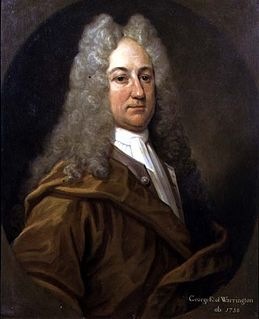
There have been three baronetcies created for persons with the surname Booth, one in the Baronetage of England and two in the Baronetage of the United Kingdom. The 1916 creation remains extant, the 1835 creation became extinct in 1896 and the 1611 baronetcy has been dormant since 1797. The senior line of the first creation was elevated to the peerage as Baron Delamer and Earl of Warrington.

Earl of Stamford was a title in the Peerage of England. It was created in 1628 for Henry Grey, 2nd Baron Grey of Groby. This Grey family descended through Lord John Grey, of Pirgo, Essex, younger son of Thomas Grey, 2nd Marquess of Dorset, and younger brother of Henry Grey, 1st Duke of Suffolk ; Suffolk was executed for treason in 1554 forfeiting his titles.

George Booth, 2nd Earl of Warrington was an English peer and landowner, who amassed a fine collection of silver.
George Parker may refer to:
Grey is a surname. It may refer to:
The Hon. Anchitell Grey was an English politician who sat in the House of Commons in two periods between 1665 and 1695. Although he spoke rarely, he kept a detailed diary of proceedings in the House of Commons, summarising the speeches he heard. The diary, published in the 18th century, is the main surviving record for the debates in Parliament in most of the period that it covers.
George Harry Grey, 5th Earl of Stamford, styled Lord Grey from 1739 to 1768, was a British nobleman, who additionally became a peer of Great Britain as Earl of Warrington in 1796.
Hon. John Grey, of Enville Hall, Staffordshire, was an English politician who sat in the House of Commons at various times between 1660 and 1698.
John Egerton may refer to:
Charles Noel Noel, 1st Earl of Gainsborough, known as Charles Edwardes until 1798, as Charles Noel between 1798 and 1823 and as the Lord Barham between 1823 and 1841, was a British peer and Whig politician.

Harry Grey, 4th Earl of Stamford was an English peer, styled Lord Grey from 1720 to 1739.
Harry Grey, 3rd Earl of Stamford, was an English peer. He was somewhat eccentric, displaying this mainly in the construction of whimsical buildings.
Ashburnham is a surname, and may refer to:
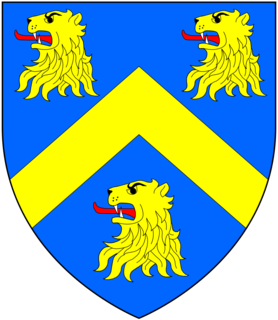
The Wyndham family are descended from Sir John Wyndham (1443–1503) and his wife Margaret (1443–1524) daughter of John Howard, Duke of Norfolk. Succeeding generations have played an important role in English politics, the law, the military and the arts.

The House of Grey is an ancient English noble family originating from Creully in Normandy. Its name, initially having been difficult to comprehend in the English language, was variously transliterated as Grey, Grai, Greye, Gray, etc.
